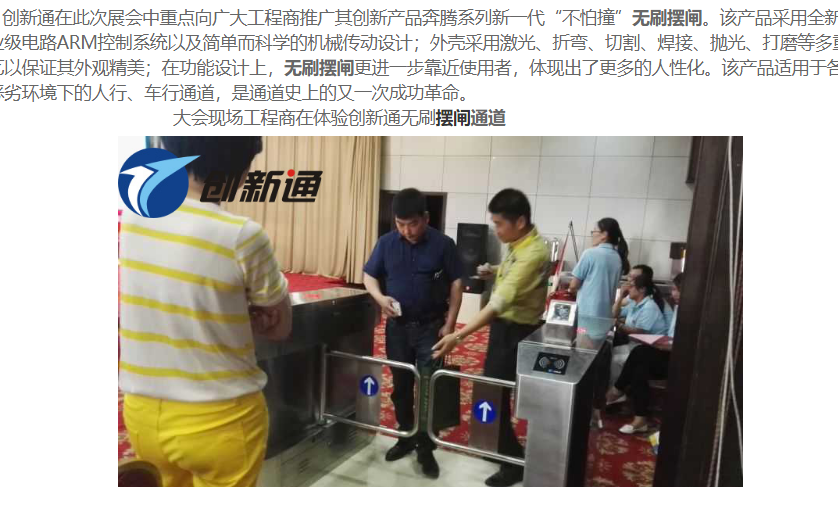 简体中文
简体中文
Introduction to the practical application of smart wing gates in various places:
With the rapid development of my country's economy and the rapid improvement of scientific and technological levels, the rational transformation of people's consumption concepts. "Smart buildings", "smart stations" and "smart communities" have sprung up all over the country, especially in large coastal cities. Factory gates (enterprises and institutions, etc.) use smart channels to realize employee attendance management, tourist attraction gates (convention and exhibition centers, station entrances and exits) use smart channels to realize ticket fee management, and one-card systems, access control attendance systems, and channel gate systems as necessary subsystems in various use occasions have also been greatly developed. (Smart channel gate + read-write recognition software system + computer background management = smart channel comprehensive management system).
So what is the smart channel comprehensive management system? With reading and writing equipment as the link, channel gates as the carrier, and computers and communication technologies as the means, various facilities are connected into an organic whole. Users can complete the usual authentication, attendance management, fee management, fund settlement and certain control operations through an IC (ID, fingerprint, face recognition object, etc.). For example, IC (ID, fingerprint, face, etc.) is used to go to restaurants, shopping, entertainment, hotels, subways, docks, conferences, parking lots, office buildings, stations and other places where paid services are provided. Instead of complicated payment and disorderly personnel as in the past. It can be seen that the intelligent channel comprehensive management system has penetrated into all aspects of enterprise management and property management, making various management tasks more efficient and scientific, and bringing convenience and safety to people's daily work and life. As a channel control device, the channel gate has been widely used in transportation, exhibition halls, factories, enterprises, institutions, scenic spots and other industries.
The following is a detailed description of the application of wing gates in factories, enterprises, institutions, community exhibition centers and other fields.
1. Introduction to channel gates
The channel gate is a control device for the flow of people. It is used in places where the entrance and exit of personnel need to be controlled, and has achieved the purpose of attendance and charging. Such as canteens, hotels, museums, gymnasiums, clubs, subways, stations, docks and other places. The use of the channel gate can make the flow of people pass through the channel in an orderly manner. According to their appearance, the channel gate can be divided into six categories: three-roller gate, barrier (wing) gate, swing gate, full-height cross gate, and barrier-free channel gate. In high-end buildings, it is recommended to use beautiful barrier (wing) gates because the flow of people is not large.
The channel gate is combined with an IC card reader to form an intelligent channel gate; the intelligent channel gate is combined with a computer and one-card management software to form an intelligent channel gate comprehensive management system, which can realize functions such as access control, attendance, and charging.
II. Case implementation in various fields
(1) Use of wing gates at the entrances and exits of buildings
Setting up intelligent swing gates at the entrances and exits of factory gates (scenic spot gates, entrances of enterprises and institutions, etc.) can effectively manage people entering and leaving the gates, thereby improving the safety and orderliness of the gates. Set up several sets of two-way swing gates at the entrances and exits (the number of swing gates is reasonably set according to the width of the channel). The staff inside the gate can freely enter and exit the channel gate with the internal employee card issued by the one-card system center. The time of people entering and leaving the swing gate is also stored in a large-capacity database for property and related personnel to query when necessary. The internal employees can also use the card swiping function to enter and exit the gate to realize the attendance management function, and the entrance swing gate can prevent the harassment of internal staff by strangers (such as malicious door-to-door salesmen).
(2) The use of wing gates in enterprises and institutions in factories and communities
The channel control function of the wing gate is used to control external visitors. When there are external visitors, the visitor first reports to the front desk reception desk, explains the reason for the visit, the person to be met and the expected visit time, and the front desk reception staff contacts the interviewee through the internal telephone of the building to confirm. After receiving the confirmation feedback from the interviewee, the reception staff uses the card issuing device to make a visitor card, enters the visitor's certification information (certificate or work permit, etc.) into the card making workstation through a special document scanner, and takes a photo of the visitor through the high-definition camera installed at the reception desk, and saves the visitor's image information into the database; the front desk reception staff then opens the corresponding permissions to the visitor (such as elevator access control, access control of the visited room, restaurant consumption, etc.) according to the information fed back by the interviewee, and sets a time limit for the visitor's time. After the visitor's information and visitor's permissions are entered, the automatic card dispenser automatically issues the card. Visitors enter the building through the building entrance wing gate with visitor cards that open corresponding permissions; when the visit is over, the visitor leaves the building through the wing gate. An automatic card receiving device for "temporary cards" is set at the exit of the passage gate. Visitors with specified time and specified permissions insert their visitor cards into the automatic card receiving machine to receive and read the cards and leave the building. When the visitor swipes the card beyond the permission or the time-out visitor card enters the card receiving device, the yellow light of the passage gate turns on and an alarm sounds to notify the staff to handle the relevant situation. At the same time, when visitors enter and exit the building entrance wing gate, the camera above the wing gate also takes pictures of the visitors and records the information and saves it in the database.
The registration and issuance of visitors and the automatic card collection of the wing gate through the automatic card issuing equipment greatly improve the management efficiency and the overall safety of the building.
(3) The use of wing gates to control the entry and exit of personnel in office buildings
A group of wing gates are set up at the entrance and exit of large conference venues to control conference attendance and participants. Participants enter and exit the venue by swiping their cards through the wing gates, which facilitates the attendance and sign-in of participants and the statistics and inquiries of conference managers; it provides an easy solution for effectively mastering and managing the entry and exit and attendance of participants. At the same time, it also politely refuses the entry of non-participants and ensures the order of the meeting. The management of the meeting through the wing gates greatly reduces the workload of conference service personnel and greatly improves the work efficiency of the exhibition.
(4) The use of wing gates to control the entry and exit of people at the entrances and exits of consumption places
In some places that implement fixed-quota consumption (canteens, hotel buffets, bathing places, etc.), a group of wing gates are set up at the entrances and exits of consumption places. Consumers swipe their cards through the wing gates to enter the consumption places. The system automatically deducts the corresponding amount according to the pre-set consumption amount, and also politely refuses unauthorized card users to enter. When the user swipes the card, the entrance channel gate will automatically display the user's card balance on the LCD screen of the gate machine. If the balance is less than the minimum balance required for one consumption, the gate machine will not open and remind the user to recharge at the recharge place. Managing these consumption places through wing gates can ensure the orderly management of these places and improve management efficiency.
III. Conclusion
The application of wing gates in high-end buildings has enriched the functions of the one-card system, and the wing gates have also improved the integration of the building to a certain extent by linking with surveillance cameras and fire protection systems (the channel gates are linked with the fire protection system, and the gates are automatically opened in case of fire alarms to facilitate the escape of personnel). Therefore, the application of wing gates in the one-card system of intelligent buildings has positive significance and application value for improving the safety of buildings and improving management efficiency.




+8613825232947


